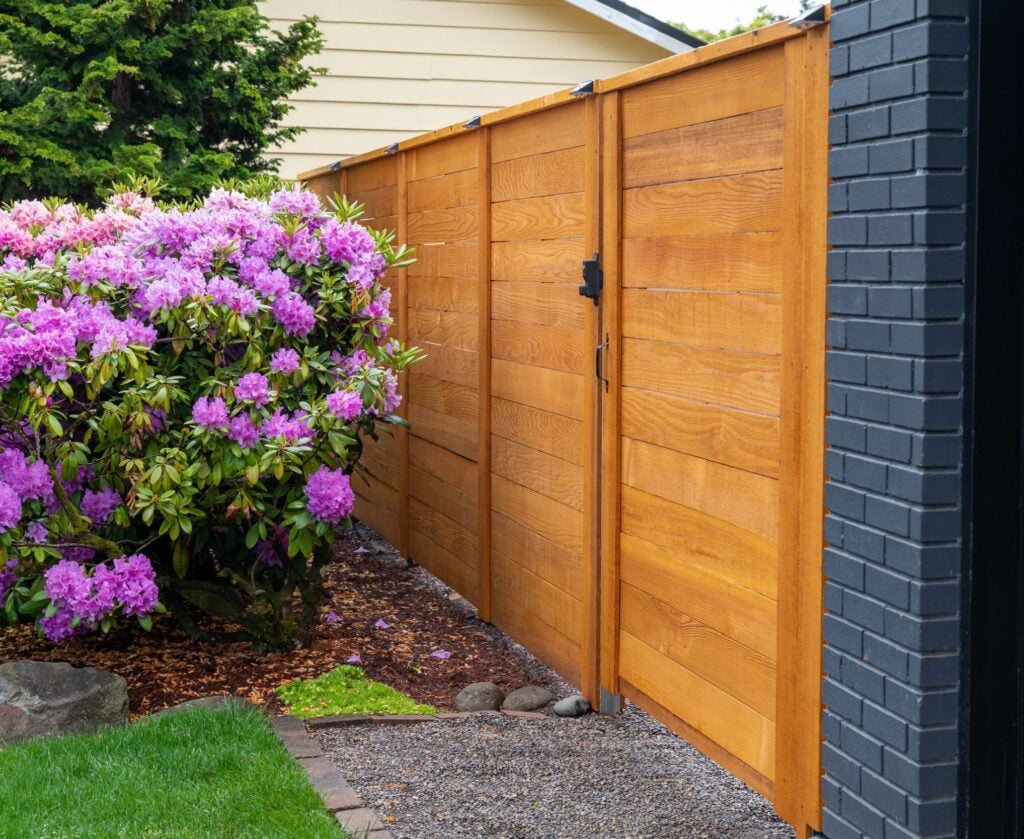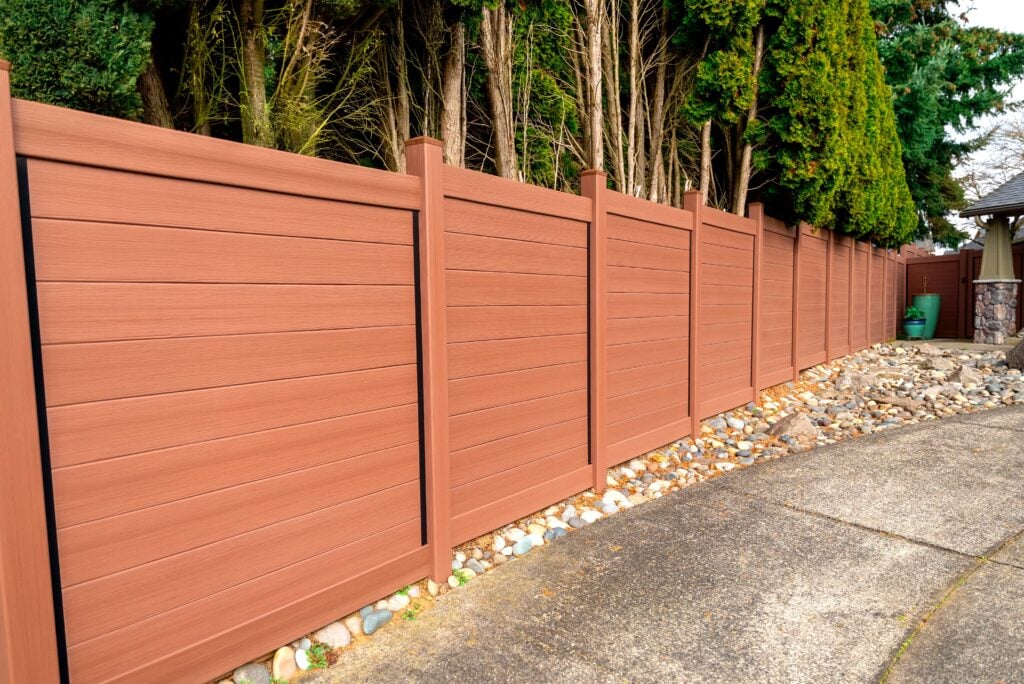At Cascade Fence and Deck, our estimators spend every day helping homeowners choose the right fence for their property. We sat down with Kurt, one of our experienced estimators, to talk through some of the most common questions people ask when planning a new fence.
What are the most common types of fences?
“The most common kind is wood,” Kurt said right away. “People have the most questions, the most experience, the most demand for just a standard wood fence. Wood is very homey. That’s why everyone likes it. It’s what their grandpa had.”
Wood has been around for thousands of years, and it still gives that classic, warm look people love. But as Kurt explained, newer materials like vinyl and aluminum bring a more modern aesthetic and much longer lifespans.
“Vinyl came around in the ’70s or ’80s,” he explains. “The more modern fences, aluminum and vinyl, look very modern, not quite as down-home. It’s very George Jetson, Tony Stark, Bruce Wayne kind of places.”
When it comes to durability, modern materials have the edge. “What you’re buying is the longevity of the product,” Kurt added. “These will all last around 50 to 60 years or longer.”
What should I consider when choosing a fence?

According to Kurt, everything starts with understanding why you want a fence. “The biggest thing is to know the reason why you’re putting a fence in, get as specific as you can.”
If your main goal is safety, you’ve got a lot of options. “The most common one is, ‘Hey, I want to keep my kiddos or dogs out of the street.’ A vinyl fence, a chain link fence, a wood fence, an aluminum fence, those will all do that for you. A wood fence will do it in the most affordable way.”
He also pointed out that a great product isn’t always the right product. “Just because something’s awesome doesn’t mean it will serve you well,” he said. “For instance, a chain link fence will last 85 years. But if you’re going to sell the house in five years, why invest in that when a standard 1950s picket fence will serve you just fine?”
And don’t forget privacy. “That’s the biggest one I get,” Kurt said. “People tell me, ‘We have a hot tub here, a barbecue here, a hammock, we’re trying to make a haven.’ If your neighbor’s yard sits higher and you order a six-foot fence when you really need six-nine, you’ll spend your entire budget and still not have the privacy you wanted.”
Weather is another big factor, especially in the Pacific Northwest. “Fences that are fine for the rest of the country are not fine here,” Kurt warned. “For example, Home Depot sells spruce panel fences, spruce is terrible for this region. It’ll fall apart in a couple of years. That’s why we use exclusively cedar.”
What’s the difference between a privacy fence and other fences?
“There’s a spectrum of privacy in just about every type of fence,” said Kurt. “And wood fences are not 100% private and that’s something we like folks to know.”
If you want complete privacy, Kurt recommended a double-picket wood fence. “That’s what we call a true wood privacy fence. There are no gaps between the pickets at all.”
He added as well, “The typical wood fences you see around have very slight gaps. You always see the cartoon of Mickey Mouse putting his eyeball right to the knothole, that’s what we’re talking about.”
Semi-private and decorative styles, like good-neighbor fences or garden fences, can strike a balance between airflow, light, and visual appeal. “It’s just good to know the level of privacy you want before you start.”
When does it make sense to repair instead of replace a fence?

“The biggest thing is the pressing nature of the repair,” Kurt said. “A lot of our repairs are, ‘My dog’s getting out!’ We can come out a lot quicker with a repair crew and get that fixed faster than a full install crew.”
Repairs can also be a great budget option. “Repairs are probably a fifth or a tenth of the cost, just to keep your fence standing,” he noted.
Cascade Fence and Deck uses a unique repair system that extends a fence’s life without total replacement. “We have a pile driver system where we drive steel piles alongside the fence and secure it to keep your fence standing,” Kurt explained. “It’s a great option if you’re not ready to replace the whole thing.”
How far apart should fence posts and rails be?
Kurt laughed when asked this one: “I’m probably going to lose the audience on this,” he joked, “but the rule of thumb, if you’re building it yourself you don’t want a 2×4 rail to span more than eight feet.”
“If you go ten feet between posts, it’ll sag over time,” he explained. “Especially here in Washington or Oregon where it rains. The fence will fail fairly often.”
He’s also a big believer in adding a third rail: “No one’s ever said, ‘My fence is sitting too straight!’ It’s a minimal cost increase, and your fence stays tall, strong, and sturdy for much longer.”
What kind of hardware and fasteners are best?
“Here’s kind of a dirty trick,” Kurt said. “Galvanized nails, they say they don’t rust, but they do. You’ll see fences with dark streaks running down from the nails. That means your fence is starting to fall apart because the fasteners are withering away.”
That’s why Cascade Fence and Deck uses stainless steel or ring-shank aluminum fasteners. “We’ve used ring-shank nails forever,” he said. “They hold tight and last. We’re all in on that, and we think homeowners should be too.”
How do materials behave over time?

“Wood is the most popular, there’s a reason you see it everywhere,” Kurt said. “But wood will definitely fail and rot compared to chain link or vinyl.”
He explained that pressure treated posts don’t last like they used to: “Once arsenic was banned from the treatment process, the posts started failing in about six years instead of twenty.”
That’s why Cascade uses steel posts for longer life. “We’re all in on steel posts,” he said. “They just last.”
As for modern materials: “Chain link and vinyl are basically invincible. Vinyl’s been around since the ’70s, and all that product is still out there. It’s basically outside a human lifetime.”
How deep should fence posts go?
“The rule of thumb is about 18 inches,” Kurt said, “but the depth isn’t as important as how much concrete you use. You want around 140 pounds of concrete per post for a six-foot fence, about two full bags.”
For taller fences, that increases. “A seven-foot fence might need 200 pounds,” he added. “If you undersize your foundation, that fence is going to start to droop over time, kind of like a boat taking on water.”
Cascade’s pile driver system eliminates that issue entirely. “We drive a steel channel three feet into the ground. It’s a modern system, even better than concrete.”
What’s the expected lifespan of each fence type?
Wood fence: 20–25 years when built right (less if not).
Vinyl fence: 50–60 years or more “pretty much a lifetime fence,” stated Kurt.
Aluminum and chain link: “Essentially forever. That stuff just doesn’t go bad.”
What kind of maintenance does each fence need?

Wood requires the most attention. “If you want to keep it looking fresh, stain it every two to three years,” Kurt said. “A lot of people don’t, which is fine, the fence will still work. But if you’ve got a beautiful landscaped area, staining helps keep it looking great.”
Vinyl fences need only an occasional cleaning. “People think vinyl fails or gets dirty looking, but really it just needs a wash. Every vinyl fence that looks dirty is three hours away with a pressure washer or car brush from looking like the day we put it in.”
As for chain link? “You just ignore it and never think about it again,” he laughed.
Final Thoughts from Kurt
When asked for his final thoughts Kurt said “If you feel weird being there, it’s not yours. You want to build a fence that makes your property yours. Keeps the kiddos out of the street, keeps your weird neighbor from seeing your hot tub, that kind of thing. It might seem simple, but it really matters.”
